Attic roof insulation: a detailed instruction on the installation of thermal insulation in the attic of a low-rise building
High-quality insulation of the attic roof is necessary if the room is supposed to be used in the winter. To perform thermal insulation work, it is not necessary to call specialists. All stages for attic insulation can be carried out independently. Doubted what happened? We will help you in solving this problem.
In the article we gave practical recommendations for choosing the optimal material, outlined the specifics of roof insulation on the outside and inside the room. In addition, we described in detail the technology of work using the two most popular heat insulators: mineral wool and polystyrene.
The content of the article:
Process Overview
Most often the attic is insulated from the inside after the main roofing work is over. Thermal insulation material is placed in the space between the rafters, after which decorative decoration of the room is performed.
It is permissible to mount a layer of insulation on top of the rafter system as part of a roofing pie, but this is an option associated with certain difficulties. There is a high probability of wetting of the insulating material, it will have to be constantly covered with something, and this is inconvenient.
Preference is given to this method only in those cases when the rafters are left in sight as part of the original interior.
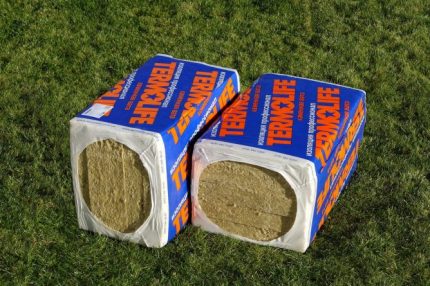
If you just need to make a warm attic, it is easier and faster to carry out internal work. They are performed after the installation of the roof is completed. When work needs to be done in a long-built house, there is no choice; the attic needs to be insulated from the inside.
The list of materials suitable for attic insulation is quite wide; the most popular heat insulators include:
- roll materials - mineral stone wool, glass wool;
- slabs - polystyrene, extruded polystyrene foam.
The thickness of the insulation is selected depending on climatic conditions.Usually, a layer of 100 mm is sufficient for the southern regions, in the temperate zone the amount of material can be increased to 150 mm, and in areas with a harsh climate, at least 200 mm of thermal insulation will be needed.
Orientation should also be on the characteristics of the particular material selected for decoration, as well as on the features of the casing. As such, use plywood, board, drywall, OSB, MDF, cork, lining, etc. You can use online calculators to perform calculations.
The most common choice when attaching the roof of the attic:
- Styrofoam - weighs less, it practically does not get wet, does not blow, but is sensitive to ultraviolet radiation and may catch fire in a fire;
- mineral wool - completely fireproof, but requires maximum protection against moisture and wind.
Mineral-cotton insulation is easier to cut into separate pieces, it is restored after compression, although serious mechanical loads are contraindicated in this case.
How to use mineral wool?
Warming with this material is as follows:
- The distance between the rafters is measured.
- Heat insulation material is cut into pieces of suitable size.
- Perform marking for fasteners on the rafters.
- Mount the brackets under the metal profile.
- Set the profile to check its position.
- Correct the position of the brackets and remove the profile.
- Pieces of mineral wool are inserted into the inter-rafter space.
- Close the laid insulation and rafters with another layer of mineral wool in a roll.
- A metal profile is installed to fix the position of the insulation.
- Double-sided tape is glued to the profile.
- A vapor barrier membrane is fixed to the tape.
- Glued joints with one-sided tape.
On this, the insulation work can be considered completed, you can install drywall, lay electric cable, perform decorative decoration, etc.
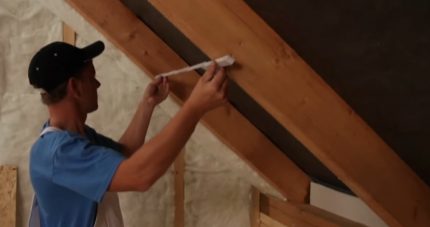
Before warming the roof of the attic from the inside, roll with cotton wool should be deployed and left for some time. During storage and transportation of the material leaves a certain amount of air, it becomes slightly thinner than stated.
It is necessary to let it lie on a flat surface in order to restore the original characteristics. You can measure pieces of mineral wool with a standard tape measure, and a building meter is also suitable. For cutting you will need a sharp knife.
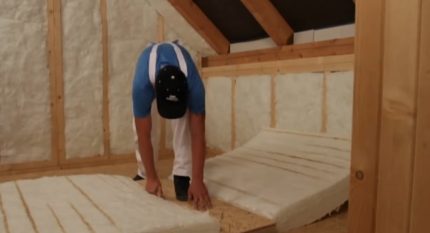
From wind protection to a marking line for the brackets, you must leave a distance that corresponds to the thickness of the insulation. Between the rows of these elements usually withstand a step of 400 mm.
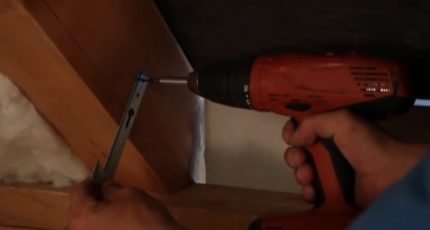
Between the edge of the bracket and the lower edge of the roofing pie, you need to leave a space that is equal to the double thickness of the insulation. This will be enough to lay the material without crushing it.
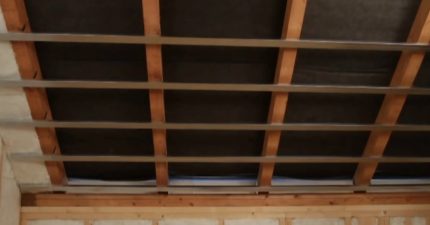
After the profile is removed, begin laying the pieces of mineral wool. It should enter the space evenly and tightly. Clearances and warps are not allowed.
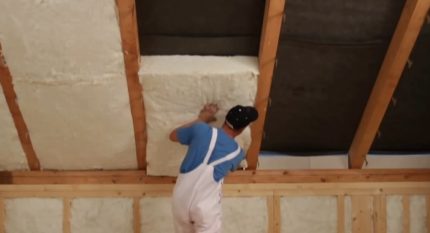
Now you need to take a roll of insulation material and roll it. He also does not hurt to give some time to “lie down” in order to restore the lost shape. A layer of insulation covers both the existing heat insulator and the ends of the rafters.
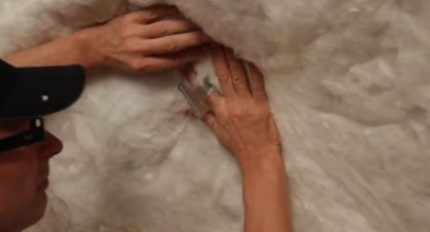
After this, you need to fix the position of the insulation. For this, the metal profile is fixed to the brackets.

Next, install a vapor barrier film. To keep it on the profile, it is enough to use double-sided tape. The material is overlapped, it is important that it always lies flat, without distortions and creases.
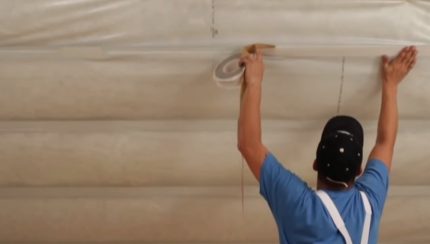
The corners of the room deserve special attention, these are difficult places. Here it is recommended to put another layer of film. To fix it, use a construction stapler and scotch tape.
So that the pieces of mineral wool do not sag during installation, it is recommended to additionally fix their position with a nylon thread. A thin copper wire is also suitable. This recommendation is also useful when using pressed cotton wool, which first holds its shape, but later tends to deform.
To increase heat efficiency, you can use not one thick layer of cotton wool, but two thin ones. The vapor barrier membrane must face the rough side inside the room, otherwise the insulation will be exposed to condensation.
A counter-lathing with a thickness of about 25 mm must be laid on the vapor barrier film to ensure normal air circulation and evaporation of moisture.
The procedure for working with foam
A description of how to insulate a mansard roof with foam can be the following series of operations:
- Insulation sheets are cut in accordance with the size of the space between the rafters.
- The foam is installed in place and fixed with a mounting foam.
- Install the second foam layer.
- All joints are re-treated with foam.
After that, you can start laying communications and decorating the room. Although the scheme looks simpler, in comparison with the insulation of the attic with mineral wool, increased demands are placed on the quality of work.
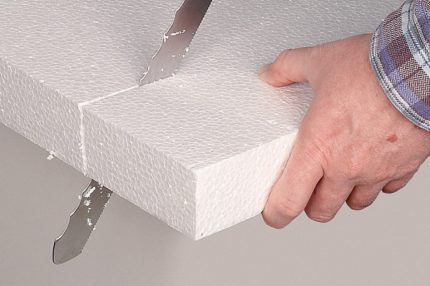
It is very important to use polyurethane foam correctly. It is blown into the places where the insulation adjoins the rafters, as well as at the joints between the individual sheets. After application, you need to wait about five minutes, only then press the next element.
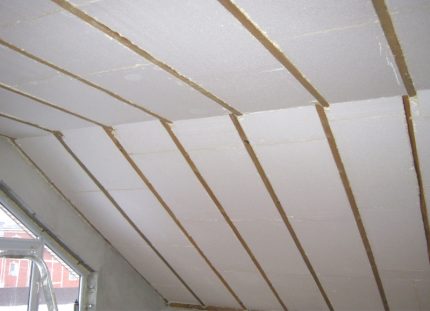
The emerging foam after solidification is cut with a knife. Before laying the next layer of polystyrene, all the edges and joints on the already installed insulation are treated with polyurethane foam.
After waiting for the necessary time, the second layer is simply pressed to the first. Additional foam is sometimes applied to improve the adhesion of the layers.
The fit of the foam layers should be as tight as possible, and the joints should not match to prevent heat leakage and condensation.
After that, all joints around the foam piece are re-blown with foam.Good sealing is the main requirement for foam insulation.
Mauerlat at the junction with the rafters deserves special attention. It is recommended that the foam be used generously in order to ensure proper sealing of this moving element.
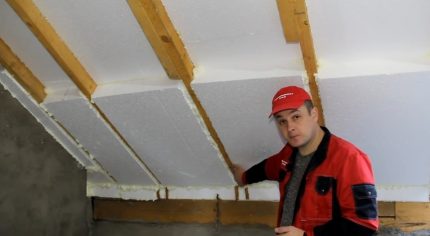
It is easier to work with polystyrene than with mineral wool. Using polyurethane foam allows you to perform all the work on the insulation of the attic roof of a private house much faster. But do not rush to the detriment of quality.
If there is a gap between the insulation layers, moisture will penetrate there, and this can eventually lead to damage to the rafter structure.
Features of the use of other materials
Extruded polystyrene foam is a good but more expensive replacement for expanded polystyrene. It is available in the form of plates. You can purchase elements with a stepped end, which will provide an exceptionally tight connection.
Slabs extruded polystyrene foam Do not lay between the rafters, but mount on top of them. The material is fixed using various adhesive compositions or self-tapping screws with an enlarged telescopic hat.
Simple installation helps to reduce the terms of work, but you should remember about the combustibility of expanded polystyrene when installing electrical wiring.
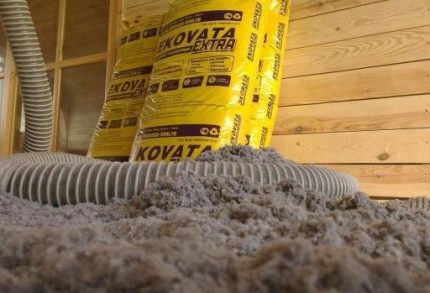
Glass wool the installation technology is similar to mineral wool insulation. But working with such material is more difficult, since protective clothing is needed to save the skin from the irritating effects of glass fiber. You will also need a protective face mask, the contact of glass wool with mucous membranes is undesirable.
Ecowool - An interesting option for insulation. This is a safe and effective material that is applied to the space between the rafters. But the work will be quite expensive.
Polyurethane foam provides extremely reliable insulation. It is applied in a continuous layer without seams. But to carry out such work independently is difficult, because this requires equipment and trained personnel.
A detailed overview of heat-insulating materials with a description of their advantages and disadvantages, as well as additional tips on choosing a heater for an attic roof are presented in this article.
Conclusions and useful video on the topic
Mineral wool insulation:
How to insulate a mansard roof with polystyrene for winter living:
To carry out the attic insulation correctly, you should choose the right material and adhere to the technology of work. High-quality insulation will not require replacement for 30-50 years or longer. But errors when laying the material can lead to damage not only to the insulation, but also to the entire roof.
Share your experience with attic roof insulation with readers. Tell us what the choice of insulation was based on, what installation technology you followed. Please leave comments on the article, ask questions and participate in discussions. The contact form is located below.

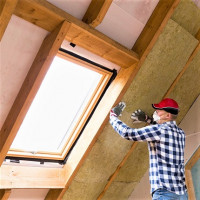 The better to insulate the attic: the best thermal insulation materials for arranging the attic roof
The better to insulate the attic: the best thermal insulation materials for arranging the attic roof 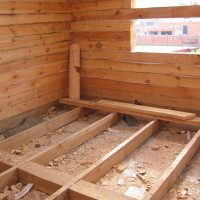 Floor insulation by logs: materials for thermal insulation + insulation schemes
Floor insulation by logs: materials for thermal insulation + insulation schemes 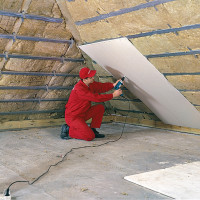 Do-it-yourself attic insulation from the inside: step-by-step instruction on insulation + tips for choosing materials
Do-it-yourself attic insulation from the inside: step-by-step instruction on insulation + tips for choosing materials 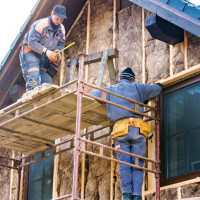 Insulation of a private house outside: popular technologies + material overview
Insulation of a private house outside: popular technologies + material overview 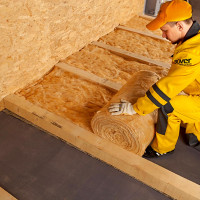 Insulation for the floor in a wooden house: materials for thermal insulation + advice on choosing insulation
Insulation for the floor in a wooden house: materials for thermal insulation + advice on choosing insulation 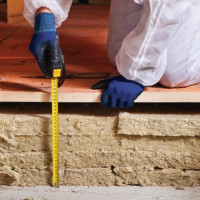 Warming of a wooden floor: popular insulation technologies + expert advice
Warming of a wooden floor: popular insulation technologies + expert advice  How much does it cost to connect gas to a private house: the price of organizing gas supply
How much does it cost to connect gas to a private house: the price of organizing gas supply  The best washing machines with dryer: model rating and customer tips
The best washing machines with dryer: model rating and customer tips  What is the color temperature of light and the nuances of choosing the temperature of the lamps to suit your needs
What is the color temperature of light and the nuances of choosing the temperature of the lamps to suit your needs  Replacement of a geyser in an apartment: replacement paperwork + basic norms and requirements
Replacement of a geyser in an apartment: replacement paperwork + basic norms and requirements